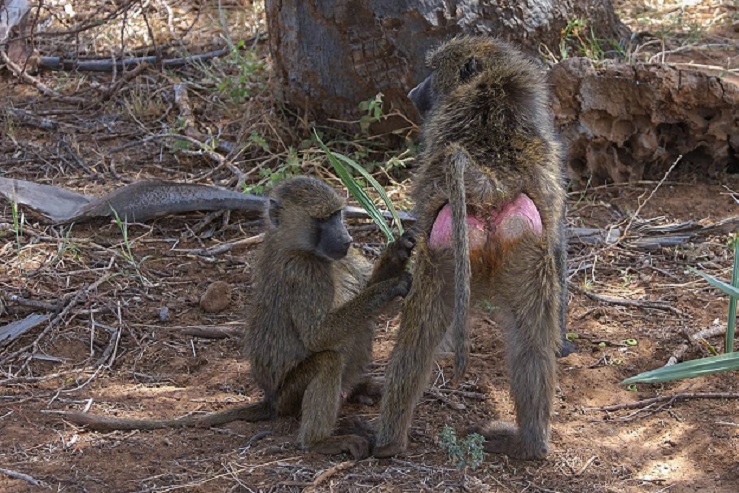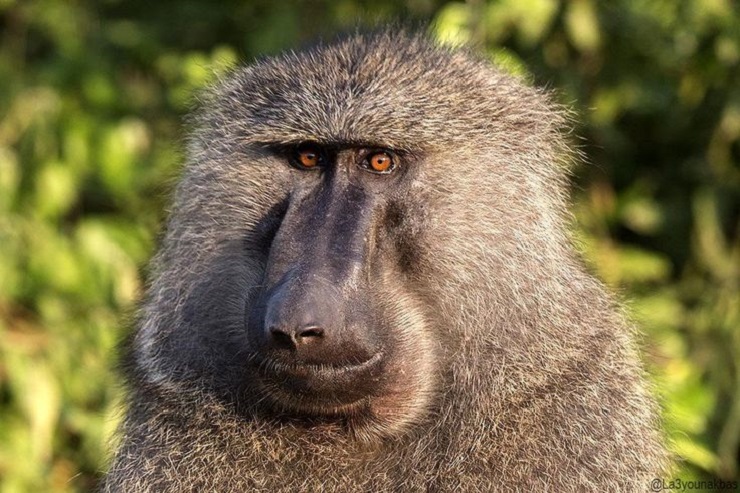Uganda is home to several primates including the Olive baboons and on any given safari here you can’t miss setting your eyes on at least one or two primates.
Uganda boasts of several primates like the Black-and-white colobus monkey, red colobus monkey, the Ugandan red-tailed monkey and blue monkey, Golden monkey, Grey-cheeked mangabey, Olive baboon, Patas monkey, L’hoest monkey, Chimpanzee and the famous Bwindi Impenetrable Forest Mountain Gorilla.
Well today in our blog post we take you on a journey to discover something about Ugandan Olive Baboons
Baboons are primates that comprise of the genus Papio, one of the 23 genera of the World of Monkeys.
The common names of the five species of baboons are the hamadryas, the Guinea (also called the western and the red), the chacma baboons, the olive and the yellow both types are “dog faced,” but the yellow’s nose turns up more than the olive’s.
The olive baboon is the only type found in Uganda, they mostly live in open woodland bordered by savanna, areas like Murchison Falls National Park, Semuliki Forest, Kibale Forest National Park, Queen Elizabeth National Park and Lake Mburo National Park being the hosts for these primates.
Behaviour
Baboons are highly social, living in social groups of around 20 to 50 animals, which usually consist of seven to eight males and approximately twice as many females and many offspring.
Baboons usually leave their sleeping places around 7 or 8 a.m. After coming down from the trees, adults sit in small groups grooming each other while the juveniles play.
They spend more time in mutual grooming, a key way of forming bonds among individuals as well as keeping the baboons clean and free of external parasites.
A troop’s home range is well-defined but does not appear to have territorial borders. It often overlaps with the range of other baboons, though they seem to avoid meeting one another.
 These family units of infants, juveniles and females form the stable core of a troop, with a ranking system that elevates certain females as leaders.
These family units of infants, juveniles and females form the stable core of a troop, with a ranking system that elevates certain females as leaders.
When they begin to mature, males leave their troops and move in and out of other troops. Frequent fights break out to determine dominance over access to meat or females.
The ranking of these males constantly changes during this period. Males are accepted into new troops slowly, usually by cohabiting with different females around the edge of a troop. They often help to defend a female and her offspring.
Feeding
Baboons are omnivorous animals and also selective eaters that choose their food carefully and their common sources of food are insects and periodically go after fish, rabbits, fowls, monkeys and antelope.
They are foragers and can be very aggressive when food is involved. Their principal predators are human beings, leopards, cheetahs. They form a cohesive unit that moves off in a column of two or three, walking until they begin feeding. Baboons usually feed as they move along, often traveling five or six miles a day.
They forage for about three hours in the morning, rest during the heat of the day and then forage again in the afternoon before returning to their sleeping places by about 6 p.m. Before retiring, they spend more time in mutual grooming.
Breeding
Baboons reach sexual maturity in five to eight years. Males leave their birth group, usually before they reach sexual maturity, whereas females stay in the same group their entire lives.
Just below the tail, on the rump area are horny epidermal callosities. With females in , the callosities swell up substantially and serve as clear signal to the males of their breeding condition.
The dominant males herd and mate with the females in oestrus. The Alpha male does most of the mating. After a successful copulation from one male or a number of different males, the female then goes through a 6 month gestation period and gives birth to a single offspring.
The females tend to be the primary caretaker of the young, although several females may share the duties for all of their offspring. The mother carries the infant next to her stomach as she travels, holding it with one hand.
By the time the young baboon is 5 to 6 weeks old it can ride on her back, hanging on by all four limbs and also spend most of its time with other baboons of its stage. Offspring are weaned after about a year.
Baboons in captivity live up to 45 years, while in the wild they live up to 30 years. Females can give birth at any time of the year.
Baboons use over 30 vocalizations ranging from grunts to barks to screams to communicate.

